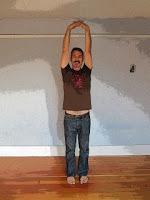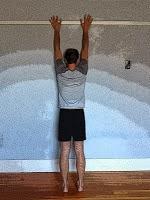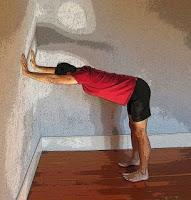
Evening Sky by Melina Meza
A long-distance trip may be in the offing for me and may involve “crossing the seven seas” as they refer to travel to Asia. I dread airline travel, especially if it involves sitting for more than five hours on a seat that is generally 17-18 inches wide with hardly any space between my knees and the seat in front of me. Added to the butt and knee discomfort, I have to deal with stiff hips, a strained back, swollen ankles and feet and finally a jet lag that just refuses to cease. Frequent trips to India and other long distance places in the past few years have become so uncomfortable that I needed to make my airline travels more memorable by reducing the hazards of prolonged sitting from long-distance travel. So I have resorted to doing—you guessed right—what I call “yoga in the skies,” yoga poses that stretch my calves, hips, knees, low back and hamstrings among other muscles.As soon as the seat belts sign are turned off, I begin my practice. Since I often have fluid accumulation in my heels, I begin with simple stretches to increase the circulation in the periphery and later move to more advanced poses depending on the availability of space inside the aircraft. Let me share my practice and you are welcome to comment on it:
1. Seated Knee to Chest: Keeping one foot flat on the floor, lift the other leg and using both palms draw your knee to your chest. Keep your shoulders relaxed throughout the pose. This is a very good pose to stretch your hips and knees as well as strengthen your back and chest. Bringing your knee towards your chest also stimulates your abdomen, thus improving the digestive fire. Hold for 30- 45 seconds. Then repeat with the other leg.
2. Seated Ankle-Knee: Keeping one foot flat on the floor, lift the other foot and place the ankle on top of the resting thigh and closer to the knee. Make sure you have enough room to drop the raised leg and knee to the side without disturbing your neighbor. Flex your foot, squeeze and spread your toes as though you were about to push the other neighbor (assuming you are sandwiched between two travelers). This helps to open the hip and give a really good stretch around the butt and hip. If you wish to get a deeper stretch, lean forward a little and place your forearms on top of your legs. If you are seated in the aisle seat, be mindful of the drinks cart! Hold for 30-45 seconds. Then repeat the pose with the other leg.
3. Seated Side Twist: Be sure to twist every so often to improve circulation especially through your lower back. This is especially beneficial when you have 8-14 hours of continuous travel time ahead of you. While on your seat, plant your feet on the floor and place your left hand on the outside of your right knee and twist to the right. If there is a provision to move your hands back, you can to deepen the twist by taking your right hand to the back of the seat. Initiating the twist from the bottom of your spine, include your head and neck in the twist. Sport a smile so you don’t surprise your neighbor. Hold for 30-45 seconds. Then repeat the pose on the other side.
After completing those initial stretches at your seat, it’s now time to take a walk. Go to the far end of the airplane where you will encounter more space near the lavatory.



5. Tree Pose: Using the same wall by the bathroom for balance if needed, place the sole of one foot against the inner thigh of your other leg and raise your arms over your head to open up tight hips and relieve any lower back pain. You may get some stares or be judged but ignore everyone and just practice!
6. Other Poses: Some airlines have nearly three feet of space between the last row of seats and the kitchen wall at the rear end of the aircraft. I find this space just sufficient to practice my Warrior poses, squats and Standing Knee to Chest pose. (See also Standing Shoulder Stretches and Opening Tight Shoulders). Now if they increased that floor space, I could defy gravity by attempting head- and handstands, perfect poses after periods of prolonged immobility to prevent deep vein thrombosis (blood clot) from setting.
Come back to your seat after you are stretched completely and end the session with few rounds of breath work/pranayama
7. Pranayama: In my opinion, it is very safe to do some pranayama techniques in an airplane owing to the high-quality air filters and a pressurized-temperature controlled cabin that releases a defined percentage of oxygen. I find solace in a 15-minute Ujjayi and Alternate Nostril (Anuloma Viloma) pranayama workout.
Without any doubt, if we resort to these few simple in-flight yoga poses and breath work, it would make air travel a better experience. Furthermore, I am thankful to those airport administrators who are catering to yoga practitioners like me by creating yoga studios for passengers in transit. How about going one step farther? How about if long-distance flights create a private space preferably for passengers in the economy seating to stretch out completely without having to worry about neighbors or the carts? Surely, there must be air pilots or airline attendants subscribing to this blog who can put in a word on our behalf. Which airline will be the first to redo their interior space?

